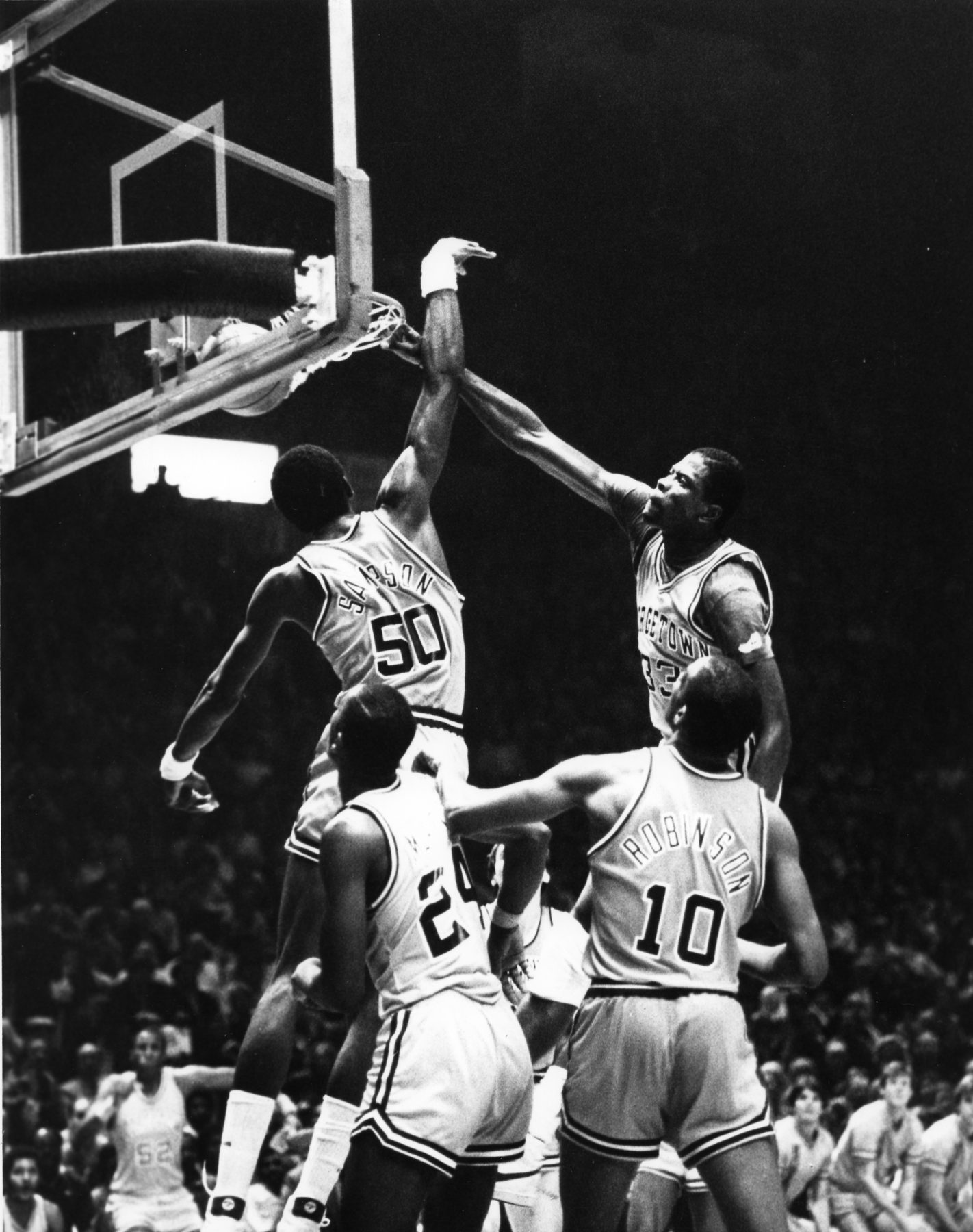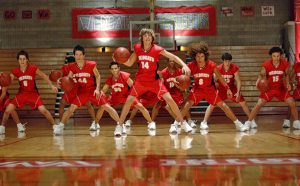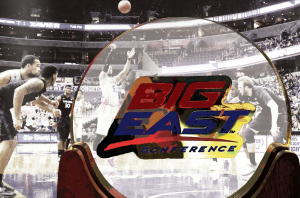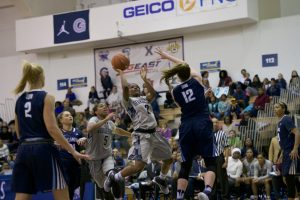Patrick Ewing (COL ’85) stepped behind the podium last April to field questions from the media in his first press conference as head coach of the Georgetown University men’s basketball program. National outlets including ESPN, the Associated Press, and Fox Sports broadcasted the event from the Thompson Athletic Center. All the while, the building’s namesake, former head coach John Thompson Jr., sat in the back of the room, eagerly watching his most illustrious former pupil take the reigns of the program they had both legitimized in the early 1980s.
Ewing’s career had seemingly come full circle; as the program’s most successful player, he had returned to the place he once called home to replace the son of his former coach, opening a new stage in his career and an opportunity to add to his legacy.
This national spectacle was only possible because Ewing faced a similar room of reporters 36 years earlier when he and his family held a press conference at Satch’s Restaurant in Boston. That day in early February 1981, Ewing announced the most influential decision of his career.
“After considering all the facts, I have decided to attend Georgetown University.”
A native of Kingston, Jamaica, Ewing moved to Cambridge, Ma. in 1975 before attending Cambridge Rindge and Latin School. As the nation’s most coveted recruit in 1981, he was often compared to 11-time NBA champion Bill Russell. His seven-foot frame, incredible shot-blocking prowess, and raw aggression made him a potentially program-defining player at a time when John Thompson Jr. and the Georgetown Hoyas were looking to break through on the national level. At that point, the team had earned three consecutive NCAA Tournament appearances, but had never advanced past the regional final. In spite of this, Ewing chose the Hoyas over local-favorite Boston College and perennial power UNC Chapel Hill.
“I chose Georgetown because of the opportunity it will give me to get an education and play basketball,” Ewing told Michael Wilbon of the Washington Post during his second semester. “I guess people can believe whatever they want about a person. I’m not going to worry about them. I’m just going to try to make the best of my years at Georgetown.”
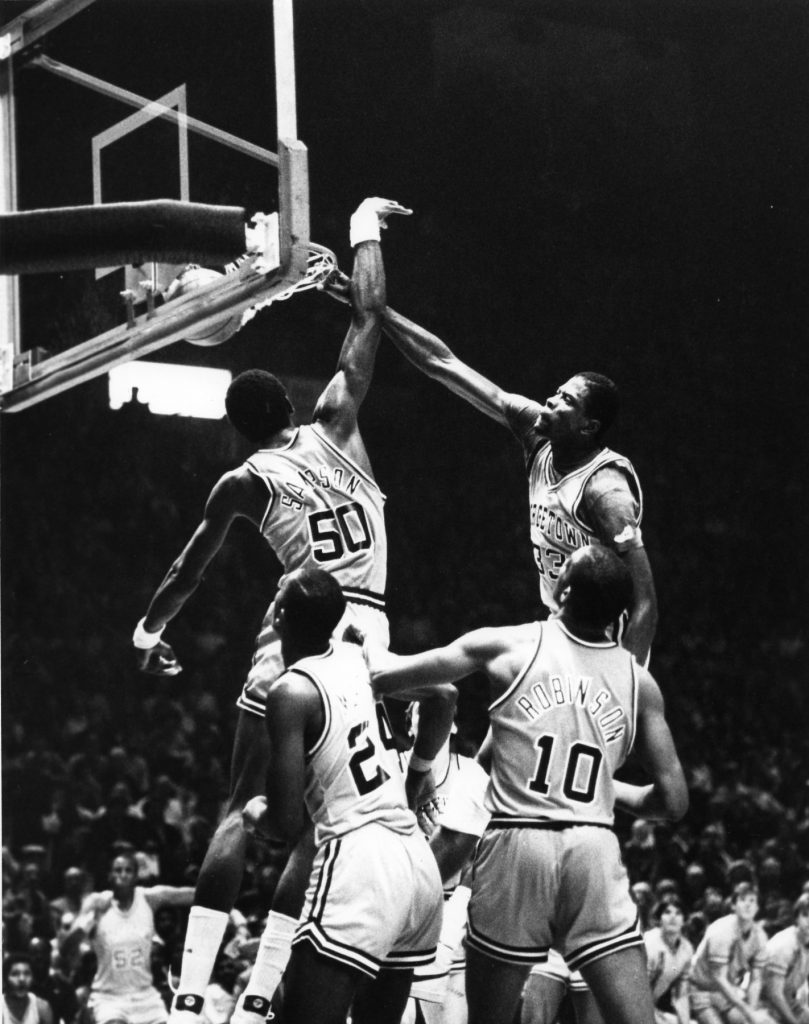
Georgetown Sports Information
His aggression on the court meshed perfectly with Thompson Jr.’s bruising style of play, which was based on a frene
tic pace, scrambling defensive traps, and physical domination. All seven feet of Ewing’s long and muscular frame made him ideal for the system, and the freshman made an immediate impact. He averaged 12.7 points, 7.5 rebounds, and 3.2 blocks per game and Georgetown went on to claim the Big East tournament crown. The Hoyas advanced to the 1982 National Championship game but fell just short of victory to future superstar Michael Jordan and his North Carolina Tar Heels.
Ewing’s domination continued through the following three seasons as he led Georgetown to the program’s only national championship in 1984, as well as the 1985 National Final, where the team lost to Big East rival Villanova, 66-64. In his college career, Ewing averaged 15.3 points, 9.2 rebounds, and 3.4 blocks per game in a program-record 143 game career.
He graduated from Georgetown as the most decorated men’s basketball player to ever don the blue and gray. He guided the team to three Final Fours, one National Championship, and was a three-time consensus First Team All-American selection (1983, 1984, 1985). His senior season, he was named the Naismith College Player of the Year.
His rapid rise to the forefront of collegiate basketball was matched by the equally swift expansion of Georgetown’s cultural presence across America. With Thompson Jr. directing traffic from the sideline and Ewing towering over everyone on the court, Georgetown seemed bigger than basketball. Thompson Jr.’s fearless and unapologetic demeanor struck a chord around the country, as did his players’ physicality. Never before had a black head coach and a black star player achieved such a consistently high level of success at the collegiate level, and people were taking note. Georgetown apparel, including the iconic Starter jacket, became a staple in pop culture.
“When the team is successful, the university is successful. I think all of that [the Starter jackets] showed how dominant we were,” Ewing said at the team’s media day.
Following his graduation in 1985, Ewing was drafted first overall by the New York Knicks. At the professional level, he terrorized opposing teams just as he had at Georgetown. He guided the Knicks to 13 consecutive playoff seasons and two NBA Finals appearances. In his 17-year career, he averaged 21.0 points, 9.8 rebounds, and 2.4 blocks per game en route to a 2008 Hall of Fame induction.
Ewing retired from playing in 2002 and immediately entered the coaching world, earning a job as assistant coach for the Washington Wizards later that year. He then moved to Houston for three seasons before taking a job as an assistant coach in 2007 with the Orlando Magic.
Ewing showed promise as an assistant, helping one of the league’s brightest young stars, Dwight Howard, develop into the most imposing center in the NBA. If Georgetown was where Ewing proved his ability as a player, Orlando was where he demonstrated his coaching acumen.
While Ewing achieved success in Orlando, John Thompson III crafted some magic of his own 847 miles north in the nation’s capital. Thompson III, who inherited the program five years after his father’s resignation and subsequent retirement, recreated a new brand of Georgetown basketball. This new brand built on the aggressive play of his father’s former teams but paired with his own Princeton offense. In just three seasons, he took the losing program he had inherited to the 2007 Final Four for the first time since Ewing’s senior season. The following year, Thompson III led the Hoyas to a 28-6 record.
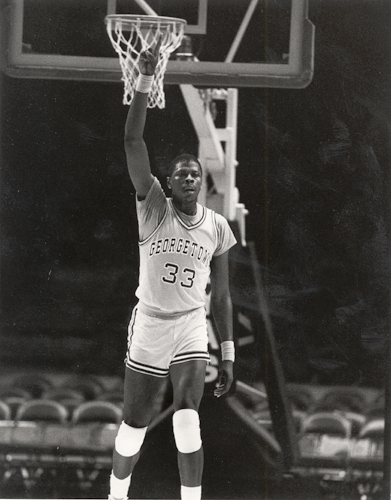
Georgetown Sports Information
In 2008, the 1984 Georgetown championship team was again operating at the top of the basketball world, with Ewing on the fast track for a head coaching job in the NBA and Thompson Jr. watching his son lead the program to the Final Four.
But things took a steady turn for the worse at the end of the decade. Despite successful regular seasons, which included a stellar 25-6 campaign in 2012-13, Thompson III was unable to lead the Hoyas out of the first weekend of NCAA Tournament play following the 2007 Final Four run. For Ewing, the waiting game in the NBA was unending. As numerous head coaching vacancies opened, Ewing was repeatedly overlooked. Mediocrity became the norm for the Hoyas, and waiting became the norm for Ewing.
Two straight losing seasons in 2015-16 and 2016-17 erased Georgetown’s status as a nataional power, and Thompson III was fired on March 23. The hole he left, however, presented an opportunity for Ewing: the chance to finally be a head coach, albeit at the collegiate level. But the opportunity was bittersweet for the man who had spent four years of his life playing for Thompson Jr.
“You know, it’s funny because I felt like I got fired … I felt for [Thompson III],” Ewing said at his introductory press conference. “I’ve known him since we both were young growing up. I remember us growing up playing in McDonough [Arena] when we were both young. The fact that he got fired, you know, it hurt.”
Ultimately, Ewing applied for the vacancy, potentially spurning his dream of coaching in the NBA. Ten days after Thompson III had been fired, Ewing was officially hired as head coach of the program he had helped build three decades prior.
“Yes, I wanted to be a NBA coach. I’ve worked extremely hard to get to that point in my career, but I thought this was a great opportunity and I took full advantage of it,” Ewing said. “I think if it was any other university, I wouldn’t be doing this. But it’s my alma mater. It’s Georgetown. I’m a Hoya.”
For long-time college basketball fans, the words “Georgetown” and “Ewing” conjure a very specific image: unapologetic, hard-nosed, bruising basketball. While he has been entrusted with elevating average teams in the past, the challenge the former center now faces as head coach at Georgetown is two-fold—he must not only return the program to its winning ways, but also restore the brand that he created as player. While it won’t be an easy task, Ewing has made it clear that he is both eager to revive the program and ready for the unique challenges that come with coaching at the collegiate level.
“I don’t see the college game any different than the NBA game. X’s and O’s is X’s and O’s. It’s all about teaching them how to play. There’s no difference. It’s all about putting them in a system and getting them to execute that system,” Ewing said at the team’s media day. “Right now, I’m not even thinking about the NBA or to prove anybody wrong. All I’m thinking about now is that I’ve been given an opportunity and I want to be as successful as I was as a player. That’s how successful I want to be as a coac

Georgetown Sports Information
h.”
Ewing will have to draw upon his 14 years of experience in the NBA coaching ranks if he wants to bring tactical changes to the team. In the months since his hire, he has repeatedly stated his intentions to bring a more up-tempo, “NBA-style” offense, as well as a more hectic, trapping defense to the Hilltop. But tactical changes alone won’t save the diminished program.
It seems that Ewing is drawing inspiration from Thompson Jr. in his efforts to rebuild. Much like Thompson Jr., Ewing scheduled an incredibly weak nonconference schedule, hoping to improve the team incrementally before the Big East schedule begins. He has also revitalized the program’s focus on recruiting within the D.C., Maryland, and Virginia areas. Georgetown once monopolized rising local talents but has since lost ground to local-rival Maryland.
“We need to get back to the way it was: No one liked us; Hoya Paranoia; smacking people around,” Ewing said. “I remember when we had things rolling here, none of the great players in this area were able to get out of D.C. when coach [Thompson Jr.] was at the helm. That’s my job, to make sure that these great players want to stay home.”
Ewing once dominated the college basketball game, building the Georgetown program with every rebound, every block, and every dunk. But in what will be the toughest task of his career, Ewing can’t rely on his own athletic abilities to lead the team back to its peak. Rather, he must draw upon his background as both a player and a coach to save a program struggling to stay afloat. He has garnered national attention for his efforts thus far, but it will all be for naught if he can’t produce wins from the bench.
“People could call me the greatest Hoya ever but, as you know, if I don’t win … there’ll be another coach here sooner or later,” he said. “We just take it at a day by day, step by step, laying the foundation. We’ll see what happens in the future. But, you know, our shield is still bright.”


